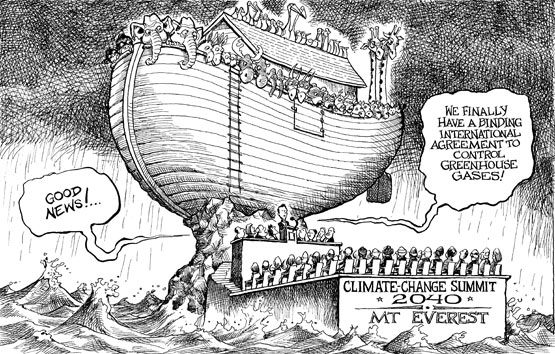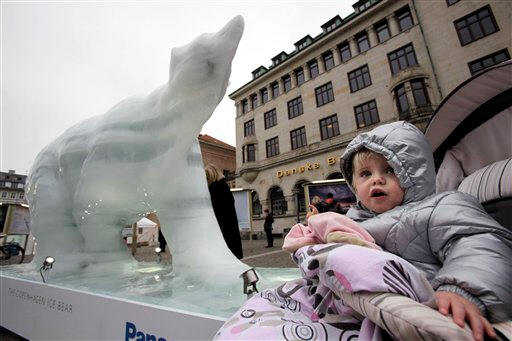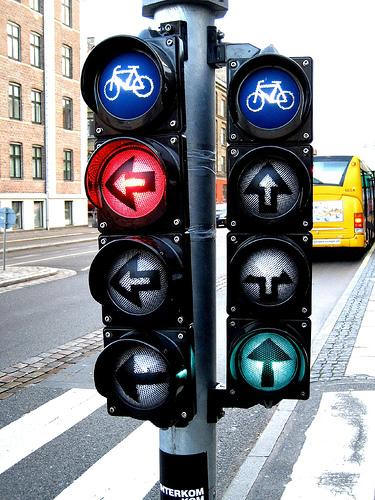
COPENHAGEN: CLIMATE CONFERENCE'S
WELL DESERVED HOST
by Nick Gier, Professor Emeritus, University of Idaho (nickgier@roadrunner.com)
Denmark Leads the World in Wind Power PDF
Danish Social Democracy and "The Third Way" PDF
A Denmark Retrospective: Fond Memories for Me and
41 Years of Socio-Economic Progress for the Danes PDF
Execute images a www.class.uidaho.edu/ngier/DKclimate.htm


from The Economist (December 10, 2009) and to the right an AP photo of a melting polar bear from Copenhagen
On the eve of the Copenhagen Climate Conference in Denmark (December 7-18), the International Advertising Association has launched a world-wide ad campaign with the catch word "Hopenhagen." This is an annoying ploy to fuse Denmark's capital and Obama's election rhetoric to convince people to support CO2 reduction. Top companies such as Coca-Cola, BMW, DuPont, Siemens, GAP, AOL, and Business Week are sponsoring this ridiculous ad campaign. Am I too cynical to think that their motives are not entirely sincere? It reminds me of extensive plans by tobacco companies to produce and market marijuana cigarettes as soon as the good weed is legalized.
On the other hand, I should be nice and assume that they are simply seeing a good business opportunity, which, by way, many green alternatives definitely are. According to a study done at the University of Massachusetts, "a $150 billion investment in clean energy could create a net increase of 1.7 million American jobs and significantly lower the national unemployment rate."
Critics say that people's ignorance of geography and world politics, especially in America, will sink the campaign from the very beginning. When traveling across the country, I find that many people don't even know where Idaho is (or confuse it with Iowa), so I tend to agree.
When I arrived in Copenhagen as a Rotary Foundation Fellow in 1966, one of the first things that I did, after drinking a few bottles of world famous beer, was to buy a bicycle. During my Rotary year there, I rode all over Copenhagen and its immediate environs. I also enjoyed the extensive suburban train network, which has now been supplemented with a subway system.
 Long
before introducing the first and longest pedestrian shopping street in 1962,
Copenhagen had built an extensive system of bike lanes, complete with their own
miniature traffic lights. For home-to-work commutes, 38 percent of
2 million Copenhageners take their bikes, while only
1.1 percent of Americans do. In 1971-72 I taught at the University of Odense,
the home of Hans Christian Andersen. With 180 miles of bike paths for a city of
160,000, and the Ministry of Transportation has declared Odense "National Cycle
City." The four-year project will focus on children, encouraging them to bike
everywhere and to feel safe in doing so. Miles and miles of dedicated bike
lanes make cycling four times safer than in the U.S.
Long
before introducing the first and longest pedestrian shopping street in 1962,
Copenhagen had built an extensive system of bike lanes, complete with their own
miniature traffic lights. For home-to-work commutes, 38 percent of
2 million Copenhageners take their bikes, while only
1.1 percent of Americans do. In 1971-72 I taught at the University of Odense,
the home of Hans Christian Andersen. With 180 miles of bike paths for a city of
160,000, and the Ministry of Transportation has declared Odense "National Cycle
City." The four-year project will focus on children, encouraging them to bike
everywhere and to feel safe in doing so. Miles and miles of dedicated bike
lanes make cycling four times safer than in the U.S.
Only the people of Holland bike more than the Danes. Daily they rack up 1.5 miles per citizen, while each Dane cycles 1 mile per day. In contrast each American bikes an average 315 feet per day. In contrast to their low commuting and shopping cycling rates, Americans put in more recreational miles than their European counterparts. Northern Europeans did not always bike this much, because they too developed a love affair with the automobile. When oil embargo hit in 1973, their governments, much more so than the U.S., committed themselves to an intensive campaign to make their countries both energy independent and energy efficient.
In Denmark years of government subsidies to wind farmers have now expired and the result is that wind provides 20 percent of Denmark's energy needs. (The discovery of North Sea oil within Danish waters made the country's goal of energy independence possible.) Denmark also helps other countries to become greener by producing and exporting one third of the world's wind turbines. On windy days Denmark exports energy to its neighbors. Using a new "smart power" grid, Denmark sells wind power that would otherwise be lost to pump water back up into Norwegian reservoirs. Plans are in the works to use erratic wind power to charge electric car batteries, or alternatively to reverse the stored energy in cars back to the grid.
My main obligation as a Rotary Fellow was to give speeches (the first one in English and next 21 in Danish) on international understanding, and I traveled to clubs all over the country by train. During my 1978-79 sabbatical to Denmark, a Social Democratic government committed itself to an ambitious program, continued by center-right governments since 1985, to phase out diesel-electric locomotives and electrify the main lines of its national rail network. The result has been the saving of hundreds of millions of liters of diesel fuel.
A similar reduction in fossil fuels consumption was achieved by building, with government funds, a 11-mile car bridge over the "Great Belt" (separating Copenhagen and its island Zeeland from the rest of the country) and digging a double-track rail tunnel underneath. Fuel hogging and inconvenient train and car ferries, which as a tourist I always thought were a lot of fun, were sold abroad or scrapped. A privately funded 10-mile rail and car bridge to Sweden has also led to significant fossil fuel savings and to greater economic cooperation and growth between Southern Sweden and Copenhagen. When the rail tunnel and car bridge from Zeeland to Germany is finished in 2012, one can could take an electric train from Stockholm to Naples without waiting for a ferry.
Over the past twenty years Denmark has reduced its CO2 emissions by 13 percent. It is on track to meet its Kyoto treaty obligations of 21 percent by 2012. Denmark ranks fifth behind Sweden, Norway, Japan, and France in CO2 "intensity," which is the ratio between CO2 emissions and real GDP. At the Copenhagen conference Denmark will, along with other European Union members, to cut CO2 emission another 20 percent by 2020. Obama's promise of 17 percent by the same date is based on 2005 figures, and this means only a 3-4 percent cut over the 1990 levels the Europeans are using.
Denmark is the most energy efficient country in the European Union at 8 percent "energy intensity," defined as the ratio of energy production to real GDP. Japan has the lowest at 5 percent. U.S. energy intensity stands at 15 percent, primarily because each American burns an average of 429 gallons of gas and diesel each year while each European uses only 76 gallons.
Denmark was able to become the King of Greens while at the same time growing its economy by 78 percent over 30 years without increasing appreciably its energy consumption. It has maintained high tax rates to make the necessary environmental investments. Another advantage is that is has alternately between budget surpluses and very low budget deficits. Year after year Denmark has been ranked among the top ten competitive economies in the world, and in 2008 the free-market journal The Economist magazine rated Denmark as the least corrupt and most business friendly country in the world. Along with Norway and the Netherlands, Denmark also has had the world's lowest unemployment rates (2-3 percent), rising only one percentage point during the current recession. Government work training programs, amounting to twenty times per capita investment than the U.S., played an essential role in this great employment success.
I submit that the Danish example, among many that can be cited from the world's progressive countries, proves that conservative critics are simply wrong to ague that keeping taxes high and going green means the ruin of a nation's economy. It was a tax-cutting, Kyoto-rejecting Bush administration and an unregulated financial system that almost destroyed the U.S. economy. Think of what a President Gore could have done with revenue lost through tax cuts for the rich, building a green economy and rescuing a failed education system.
Under both left-wing and right-wing governments (mostly the latter since 1985), Denmark has chosen to invest heavily in physical infrastructure and human capital and now has much to show for its wise decisions. The Danes have more than earned the right to host the most important international conference of the 21st Century. Nuclear annihilation was the greatest threat in the late 20th Century, but dangers of global warming, while slow and subtle, may lead to the end of the conditions that made human civilization possible on our planet.
Nick Gier taught philosophy at the University of Idaho for 31 years.